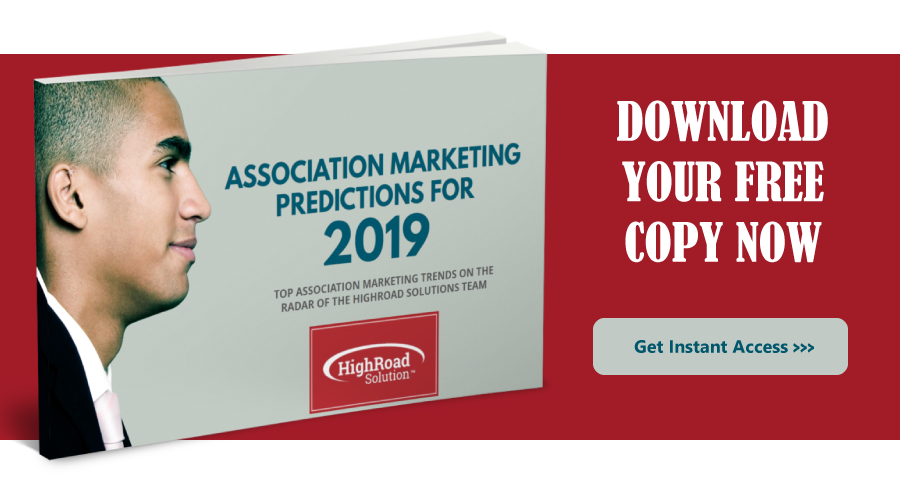6-Step Guide To Setting Up Lead Scoring At Your Association To Increase Membership, Revenue, and Event Registration
Lead Generation & Growth Strategies | Marketing Automation | Lead Scoring
Each individual member of your target audience is a on a journey of discovery and fulfillment, spanning from personal needs to career goals. This journey begins long before they are members of your association and extends throughout their professional life.
They are learning about your industry, determining what your organization offers (programs, benefits, events, etc.), discovering opportunities to get involved, and figuring out where they fit into it during different phases of their career.
With everyone at a different point in their journey, it is imperative that modern associations have a way to know what each person needs – and when. This can be very difficult if your organization doesn’t have a system. This is typically the point where most associations give up and send one-size-fits-all marketing messages that at best don’t convert, and at worst may alienate members.
Increasingly, associations are utilizing lead scoring systems to address this dilemma. By helping association staff identify the prospects who are most likely to join, purchase, or donate at the highest levels, lead scoring allows associations to focus on their best prospects and opportunities in more efficient ways.
Why is there confusion around lead scoring at associations?
Before moving forward with setting up a lead scoring model for your association, it’s important to understand what lead scoring is—and what it is not.
What is lead scoring for associations?
Lead scoring is a system your sales, membership, events, and marketing staff use to determine the situation, needs, and value of each member, prospective member, or potential customer based on their interest in and interactions with your association.
 Your lead scoring system assigns a point value to your leads' engagement levels with your association to help you qualify them as “hot,” “warm,” or “cold” based on the predictive value of those interactions.
Your lead scoring system assigns a point value to your leads' engagement levels with your association to help you qualify them as “hot,” “warm,” or “cold” based on the predictive value of those interactions.
An effective lead scoring model evaluates omnichannel interactions for each individual, combining multiple sources and methods of engaging with your association.
It assesses the types of content each person consumes, how they interact with that content, and whether those engagements result in conversions such as joining or renewing a membership, purchasing association merchandise, registering for an event, or advocating for your association.
What lead scoring is not
As you work to implement a lead scoring system for your association, it’s critical to avoid the common pitfall of using only one metric to score members and prospective members. Scoring leads based on interactions with only one channel (such as email or website analytics) may not show the full picture of your prospective members’ level of engagement.
Including multiple data points in your lead scoring model allows you to pinpoint critical indicators of deeper engagement, helping your staff pursue promising leads and avoid spending needless time on poor ones.
In addition to including multichannel interactions, integrating the membership data in your AMS with your lead scoring model provides additional data points for lead scoring.
How to set up lead scoring for your association
Step #1) Determine lead criteria
Before you begin setting up a lead scoring system for your association, it is critical to determine the criteria you will use to score your association’s leads.
Start with minimum criteria – are there any essential qualifications a lead must possess in order to become a member? Next, look at the qualities your high-converting leads usually possess and identify any common characteristics.
Follow this up by listing characteristics of your ideal leads: the “perfect” prospects who are most likely to become members or move to a deeper level of engagement with your organization. Finally, identify any characteristics or actions that would strongly indicate that a visitor or contact is not likely to become a lead.
Step #2) List all possible behaviors leads can engage in
Don’t leave anything out – it’s important to score the entire member cycle so you can deliver leads to your sales team or membership director at the moment when they’re most primed to convert.
Some of the behaviors your association might consider scoring include email opens, clicks, replies, and forwards; social media shares; website sessions, page visits, and on-page interactions; downloads and form submissions; event attendance; and contact requests. Look at your marketing automation platform to identify which digital metrics it collects.
Use Google Analytics to help you identify which behaviors are “critical conversion behaviors” – actions the majority of your leads take prior to becoming members – so you can give these the appropriate emphasis when it’s time to assign points.
Step #3) Decide on a point system
Whether you use a straightforward 1-100 scale or a mostly customized point-blocking system, it is important to remember to score your leads on both fit and interest for the most complete picture of where your leads are in the conversion cycle.
Look back at the criteria you determined in step one. Assign large blocks of points to your minimum criteria qualifications and negative point values to your negative criteria to ensure these contacts never reach “lead” status, no matter how many behavior-based points they receive.
Step #4) Distribute points
Start by assigning a maximum number of points to each category of behavior rules, and then distribute those points to the individual rules within each category. This approach will result in a more balanced scoring system that avoids high scores based primarily on only one or two factors.
Step #5) Set your lead score threshold
Determine how high a lead’s score needs to be in order to be considered “qualified.” Consider using separate score thresholds and scoring rules for different audience segments (e.g., volunteer vs major donor prospects).
Step #6) Refine and adjust
Regular evaluation of your association's lead scoring system is critical – you will want to review your data at least every 30 days at first. Analyze how well the system is working and make adjustments where needed. Pay special attention to situations where low-scoring leads ended up converting, or where high-scoring leads didn’t convert.
Association Lead Scoring Takeaway
Setting up an effective lead scoring model requires time and collaborative effort from an association’s leadership, sales, and marketing teams. When implemented correctly, however, an intelligent lead scoring system is a powerful tool that delivers increased effectiveness, engagement, and ultimately revenue to support your association’s mission.
About Maneesha Manges
Maneesha Manges is a seasoned digital marketing professional with 20 years of experience working in multiple markets and global companies. Her prior experience includes consulting roles in digital marketing strategy, data analysis, field marketing and social media. Maneesha holds a Master of Business Administration degree in High-Tech Marketing from American University’s Kogod School of Business and a Bachelor of Arts degree in Economics from Concordia University in Montreal.







